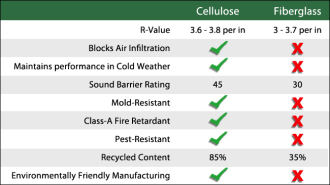Wall & Attic Insulation
Cellulose vs Fiberglass and Foam
Regarding wall insulation:
Cellulose insulation is pneumatically blown into wall cavities in such a manner that the cavity is completely filled, leaving no voids due to electrical wires, pipes or inset stapling. Thus the effective R-value for cellulose insulation is as claimed, completely filling the wall cavity, snuggling tightly around wires, pipes, electrical outlets and other obstructions.
Fiberglass insulation on the other hand are stuffed into the wall cavity with their edges stapled to the inside framing and compressed around wires, pipes, electrical outlets, etc. This leaves air pockets or voids throughout the wall cavity, thus reducing the effective R-value from that claimed. According to a study conducted by National Research Council of Canada, the claimed R-value of fiberglass batts degrades by 14% to 35% due to voids or areas around pipes, wires, electrical outlets, etc. left without insulation. In another study conducted by the National Association of Home Builders (NAHB), found that 2x6 walls insulated with fiberglass batts lost 46% of their R-value due to voids.
Foam insulation can fill the entire wall cavity but is rarely installed to do so. Most applicators only fill 85% of the wall cavity in order to avoid the time, labor and wasted foam created when the excess foam protruding beyond the framing is sawed or cut away. More importantly, by filling only 85% of the wall cavity, the effective R-value of foam insulation is reduced by 15%. In addition, during application, the rapidly expanding foam on occasion will fold onto itself creating air-pockets or voids, thus reducing the effective R-value.
Regarding attic insulation:
Cellulose insulation performs as well in attics as it does when tested under laboratory conditions. Blown on attic floors, filling all cavities, nooks and crannies, it provides the effective R-value claimed on its label.
Fiberglass insulation suffers from a drop in effective R-value in cold climates. Oak Ridge National Laboratory (ORNL) found that the efficiency (R-value) of fiberglass blown-in loose-fill in attics decreased as much as 50% as temperature was lowered from +45˚ F to -18˚F.
Foam insulation also provides the R-value claimed with one exception: during application, the rapidly expanding foam occasionally folds on itself leaving air-pockets or voids. Again, these voids or air-pockets result in reduced R-value from that claimed on their label.


